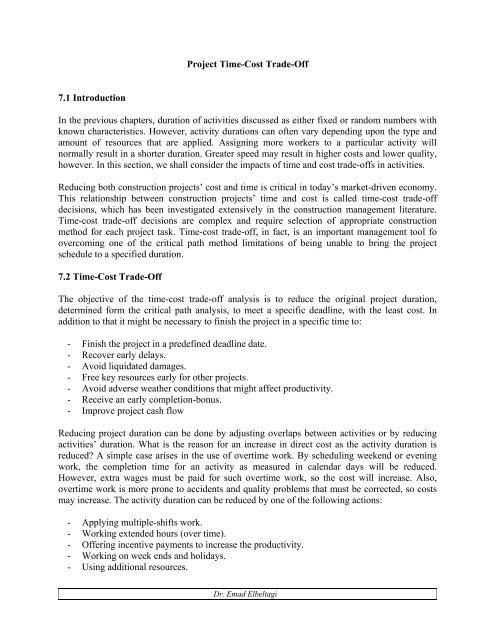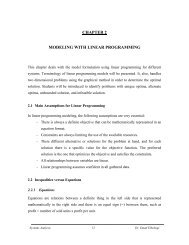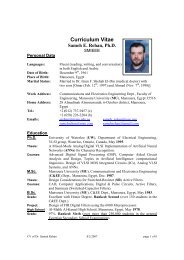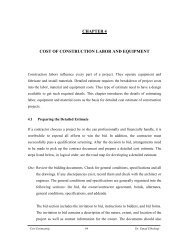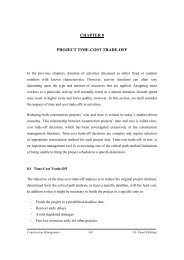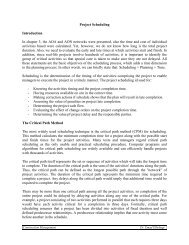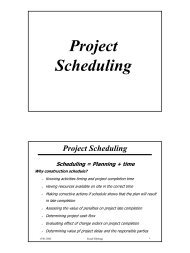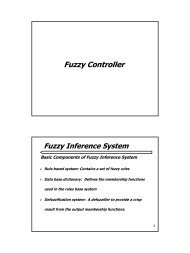Project Time-Cost Trade-Off 7.1 Introduction In the previous chapters ...
Project Time-Cost Trade-Off 7.1 Introduction In the previous chapters ...
Project Time-Cost Trade-Off 7.1 Introduction In the previous chapters ...
Create successful ePaper yourself
Turn your PDF publications into a flip-book with our unique Google optimized e-Paper software.
<strong>Project</strong> <strong>Time</strong>-<strong>Cost</strong> <strong>Trade</strong>-<strong>Off</strong><strong>7.1</strong> <strong><strong>In</strong>troduction</strong><strong>In</strong> <strong>the</strong> <strong>previous</strong> <strong>chapters</strong>, duration of activities discussed as ei<strong>the</strong>r fixed or random numbers withknown characteristics. However, activity durations can often vary depending upon <strong>the</strong> type andamount of resources that are applied. Assigning more workers to a particular activity willnormally result in a shorter duration. Greater speed may result in higher costs and lower quality,however. <strong>In</strong> this section, we shall consider <strong>the</strong> impacts of time and cost trade-offs in activities.Reducing both construction projects’ cost and time is critical in today’s market-driven economy.This relationship between construction projects’ time and cost is called time-cost trade-offdecisions, which has been investigated extensively in <strong>the</strong> construction management literature.<strong>Time</strong>-cost trade-off decisions are complex and require selection of appropriate constructionmethod for each project task. <strong>Time</strong>-cost trade-off, in fact, is an important management tool foovercoming one of <strong>the</strong> critical path method limitations of being unable to bring <strong>the</strong> projectschedule to a specified duration.7.2 <strong>Time</strong>-<strong>Cost</strong> <strong>Trade</strong>-<strong>Off</strong>The objective of <strong>the</strong> time-cost trade-off analysis is to reduce <strong>the</strong> original project duration,determined form <strong>the</strong> critical path analysis, to meet a specific deadline, with <strong>the</strong> least cost. <strong>In</strong>addition to that it might be necessary to finish <strong>the</strong> project in a specific time to:- Finish <strong>the</strong> project in a predefined deadline date.- Recover early delays.- Avoid liquidated damages.- Free key resources early for o<strong>the</strong>r projects.- Avoid adverse wea<strong>the</strong>r conditions that might affect productivity.- Receive an early completion-bonus.- Improve project cash flowReducing project duration can be done by adjusting overlaps between activities or by reducingactivities’ duration. What is <strong>the</strong> reason for an increase in direct cost as <strong>the</strong> activity duration isreduced? A simple case arises in <strong>the</strong> use of overtime work. By scheduling weekend or eveningwork, <strong>the</strong> completion time for an activity as measured in calendar days will be reduced.However, extra wages must be paid for such overtime work, so <strong>the</strong> cost will increase. Also,overtime work is more prone to accidents and quality problems that must be corrected, so costsmay increase. The activity duration can be reduced by one of <strong>the</strong> following actions:- Applying multiple-shifts work.- Working extended hours (over time).- <strong>Off</strong>ering incentive payments to increase <strong>the</strong> productivity.- Working on week ends and holidays.- Using additional resources.Dr. Emad Elbeltagi
- Using materials with faster installation methods.- Using alternate construction methods or sequence.7.3 Activity <strong>Time</strong>-<strong>Cost</strong> Relationship<strong>In</strong> general, <strong>the</strong>re is a trade-off between <strong>the</strong> time and <strong>the</strong> direct cost to complete an activity; <strong>the</strong>less expensive <strong>the</strong> resources, <strong>the</strong> larger duration <strong>the</strong>y take to complete an activity. Shortening <strong>the</strong>duration on an activity will normally increase its direct cost which comprises: <strong>the</strong> cost of labor,equipment, and material. It should never be assumed that <strong>the</strong> quantity of resources deployed and<strong>the</strong> task duration are inversely related. Thus one should never automatically assume that <strong>the</strong>work that can be done by one man in 16 weeks can actually be done by 16 men in one week.A simple representation of <strong>the</strong> possible relationship between <strong>the</strong> duration of an activity and itsdirect costs appears in Figure <strong>7.1</strong>. Considering only this activity in isolation and withoutreference to <strong>the</strong> project completion deadline, a manager would choose a duration which impliesminimum direct cost, called <strong>the</strong> normal duration. At <strong>the</strong> o<strong>the</strong>r extreme, a manager might chooseto complete <strong>the</strong> activity in <strong>the</strong> minimum possible time, called crashed duration, but at amaximum cost.<strong>Cost</strong>Crash duration&Crash costNormal duration&Normal cost<strong>Time</strong>Figure <strong>7.1</strong>: Illustration of linear time/cost trade-off for an activityThe linear relationship shown in <strong>the</strong> Figure <strong>7.1</strong> between <strong>the</strong>se two points implies that anyintermediate duration could also be chosen. It is possible that some intermediate point mayrepresent <strong>the</strong> ideal or optimal trade-off between time and cost for this activity. The slope of <strong>the</strong>line connecting <strong>the</strong> normal point (lower point) and <strong>the</strong> crash point (upper point) is called <strong>the</strong> costslope of <strong>the</strong> activity. The slope of this line can be calculated ma<strong>the</strong>matically by knowing <strong>the</strong>coordinates of <strong>the</strong> normal and crash points.<strong>Cost</strong> slope = crash cost – normal cost / normal duration – crash durationAs shown in Figures <strong>7.1</strong>, 7.2, and 7.3, <strong>the</strong> least direct cost required to complete an activity iscalled <strong>the</strong> normal cost (minimum cost), and <strong>the</strong> corresponding duration is called <strong>the</strong> normalDr. Emad Elbeltagi
duration. The shortest possible duration required for completing <strong>the</strong> activity is called <strong>the</strong> crashduration, and <strong>the</strong> corresponding cost is called <strong>the</strong> crash cost. Normally, a planner start his/herestimation and scheduling process by assuming <strong>the</strong> least costly option<strong>Cost</strong>Crash duration&Crash costNormal duration&Normal cost<strong>Time</strong>Figure 7.2: Illustration of non-linear time/cost trade-off for an activity<strong>Cost</strong>Crash duration&Crash costNormal duration&Normal cost<strong>Time</strong>Figure 7.3: Illustration of discrete time/cost trade-off for an activityExample <strong>7.1</strong>A subcontractor has <strong>the</strong> task of erecting 8400 square meter of metal scaffolds. The contractor canuse several crews with various costs. It is expected that <strong>the</strong> production will vary with <strong>the</strong> crewsize as given below:Dr. Emad Elbeltagi
Estimated daily production(square meter)166204230Crew size(men)567Crew formation1 scaffold set, 2 labors, 2 carpenter, 1 foreman2 scaffold set, 3 labors, 2 carpenter, 1 foreman2 scaffold set, 3 labors, 3 carpenter, 1 foremanConsider <strong>the</strong> following rates: Labor LE96/day; carpenter LE128/day; foreman LE144/day andscaffolding LE60/day. Determine <strong>the</strong> direct cost of this activity considering different crewsformation.SolutionThe duration for installing <strong>the</strong> metal scaffold can be determined by dividing <strong>the</strong> total quantity by<strong>the</strong> estimated daily production. The cost can be determined by summing up <strong>the</strong> daily cost of eachcrew and <strong>the</strong>n multiply it by <strong>the</strong> duration of using that crew. The calculations are shown in <strong>the</strong>following table.Crew size Duration (days) <strong>Cost</strong> (LE)56750.6 (use 51)41.2 (use 42)36.5 (use 37)51 x (1x60 + 2x96 + 2x128 + 1x144) = 3325242 x (2x60 + 3x96 + 2x128 + 1x144) = 3393637 x (2x60 + 3x96 + 3x128 + 1x144) = 34632This example illustrates <strong>the</strong> options which <strong>the</strong> planner develops as he/she establishes <strong>the</strong> normalduration for an activity by choosing <strong>the</strong> least cost alternative. The time-cost relationship for thisexample is shown in Figure 7.4. The cost slop for this activity can be calculates as follow:<strong>Cost</strong> slope 1 (between points 1 and 2) = (33936 – 33252) / (51 – 42) = 76.22 LE/day<strong>Cost</strong> slope 2 (between points 2 and 3) = (34632 – 33936) / (42 – 37) = 139.2 LE/day<strong>Cost</strong> (LE)3480034600344003420034000338003360033400332003300032130 35 40 45 50 55Duration (days)Figure 7.4: <strong>Time</strong>-cost relationship of Example <strong>7.1</strong>Dr. Emad Elbeltagi
7.4 <strong>Project</strong> <strong>Time</strong>-<strong>Cost</strong> RelationshipTotal project costs include both direct costs and indirect costs of performing <strong>the</strong> activities of <strong>the</strong>project. Direct costs for <strong>the</strong> project include <strong>the</strong> costs of materials, labor, equipment, andsubcontractors. <strong>In</strong>direct costs, on <strong>the</strong> o<strong>the</strong>r hand, are <strong>the</strong> necessary costs of doing work which cannot be related to a particular activity, and in some cases can not be related to a specific project.If each activity was scheduled for <strong>the</strong> duration that resulted in <strong>the</strong> minimum direct cost in thisway, <strong>the</strong> time to complete <strong>the</strong> entire project might be too long and substantial penaltiesassociated with <strong>the</strong> late project completion might be incurred. Thus, planners perform what iscalled time-cost trade-off analysis to shorten <strong>the</strong> project duration. This can be done by selectingsome activities on <strong>the</strong> critical path to shorten <strong>the</strong>ir duration.As <strong>the</strong> direct cost for <strong>the</strong> project equals <strong>the</strong> sum of <strong>the</strong> direct costs of its activities, <strong>the</strong>n <strong>the</strong>project direct cost will increase by decreasing its duration. On <strong>the</strong> o<strong>the</strong>r hand, <strong>the</strong> indirect costwill decrease by decreasing <strong>the</strong> project duration, as <strong>the</strong> indirect cost are almost a linear functionwith <strong>the</strong> project duration. Figure 7.5 illustrates <strong>the</strong> direct and indirect cost relationships with <strong>the</strong>project duration.<strong>Project</strong> cost<strong>Project</strong> durationFigure 7.5: <strong>Project</strong> time-cost relationshipThe project total time-cost relationship can be determined by adding up <strong>the</strong> direct cost andindirect cost values toge<strong>the</strong>r as shown in Figure 7.5. The optimum project duration can bedetermined as <strong>the</strong> project duration that results in <strong>the</strong> least project total cost.7.5 Shortening <strong>Project</strong> DurationThe minimum time to complete a project is called <strong>the</strong> project-crash time. This minimumcompletion time can be found by applying critical path scheduling with all activity durations setto <strong>the</strong>ir minimum values. This minimum completion time for <strong>the</strong> project can <strong>the</strong>n be used toDr. Emad Elbeltagi
determine <strong>the</strong> project-crash cost. Since <strong>the</strong>re are some activities not on <strong>the</strong> critical path that canbe assigned longer duration without delaying <strong>the</strong> project, it is advantageous to change <strong>the</strong> allcrashschedule and <strong>the</strong>reby reduce costs.Heuristic approaches are used to solve <strong>the</strong> time/cost tradeoff problem such as <strong>the</strong> cost-lopemethod used in this chapter. <strong>In</strong> particular, a simple approach is to first apply critical pathscheduling with all activity durations assumed to be at minimum cost. Next, <strong>the</strong> planner canexamine activities on <strong>the</strong> critical path and reduce <strong>the</strong> scheduled duration of activities which have<strong>the</strong> lowest resulting increase in costs. <strong>In</strong> essence, <strong>the</strong> planner develops a list of activities on <strong>the</strong>critical path ranked with <strong>the</strong>ir cost slopes. The heuristic solution proceeds by shorteningactivities in <strong>the</strong> order of <strong>the</strong>ir lowest cost slopes. As <strong>the</strong> duration of activities on <strong>the</strong> shortest pathare shortened, <strong>the</strong> project duration is also reduced. Eventually, ano<strong>the</strong>r path becomes critical, anda new list of activities on <strong>the</strong> critical path must be prepared. Using this way, good but notnecessarily optimal schedules can be identified.The procedure for shortening project duration can be summarized in <strong>the</strong> following steps:1. Draw <strong>the</strong> project network.2. Perform CPM calculations and identify <strong>the</strong> critical path, use normal durations and costsfor all activities.3. Compute <strong>the</strong> cost slope for each activity from <strong>the</strong> following equation:cost slope = crash cost – normal cost / normal duration – crash duration4. Start by shortening <strong>the</strong> activity duration on <strong>the</strong> critical path which has <strong>the</strong> least cost slopeand not been shortened to its crash duration.5. Reduce <strong>the</strong> duration of <strong>the</strong> critical activities with least cost slope until its crash duration isreached or until <strong>the</strong> critical path changes.6. When multiple critical paths are involved, <strong>the</strong> activity(ies) to shorten is determined bycomparing <strong>the</strong> cost slope of <strong>the</strong> activity which lies on all critical paths (if any), with <strong>the</strong>sum of cost slope for a group of activities, each one of <strong>the</strong>m lies on one of <strong>the</strong> criticalpaths.7. Having shortened a critical path, you should adjust activities timings, and floats.8. The cost increase due to activity shortening is calculated as <strong>the</strong> cost slope multiplied by <strong>the</strong>time of time units shortened.9. Continue until no fur<strong>the</strong>r shortening is possible, and <strong>the</strong>n <strong>the</strong> crash point is reached.10. The results may be represented graphically by plotting project completion time againstcumulative cost increase. This is <strong>the</strong> project direct-cost / time relationship. By adding <strong>the</strong>Dr. Emad Elbeltagi
project indirect cost to this curve to obtain <strong>the</strong> project time / cost curve. This curve gives<strong>the</strong> optimum duration and <strong>the</strong> corresponding minimum cost.Example 7.2Assume <strong>the</strong> following project data given in Table <strong>7.1</strong>. It is required to crash <strong>the</strong> project durationfrom its original duration to a final duration of 110 days. Assume daily indirect cost of LE 100.Table <strong>7.1</strong>: Data for Example 7.2ActivityPreceded byNormalCrashDuration (day) <strong>Cost</strong> (LE) Duration (day) <strong>Cost</strong> (LE)ABCDEF--BCD, FB12020403050601200018001600014003600135001001530204045140002800220002000480018000SolutionThe cost slope of each activity is calculated. Both <strong>the</strong> crashability and <strong>the</strong> cost slope are shownbeneath each activity in <strong>the</strong> precedence diagram. The critical path is B-C-D-E and <strong>the</strong> projectduration in 140 days. <strong>Project</strong> total normal direct cost = sum of normal direct costs of all activities= LE 48300.0 120A (120)20 140140 140End (0)140 1400 0Start (0)0 020@10020 60C (40)20 6060 90D (30)60 9090 140E (50)90 14010@60010@6010@1200 20B (20)0 2020 80F (60)30 905@20015@3001. The activity on <strong>the</strong> critical path with <strong>the</strong> lowest cost slope is D, this activity can be crashedby 10 days. Then adjust timing of <strong>the</strong> activities.Dr. Emad Elbeltagi
0 120A (120)10 130130 130End (0)130 1300 0Start (0)0 020@10020 60C (40)20 6060 80D (20)60 8080 130E (50)80 13010@60010@1200 20B (20)0 2020 80F (60)20 805@200 15@300A new critical path will be formed, B-F-E.New <strong>Project</strong> duration is 130 days.The project direct cost is increased by 10 x 60 = LE 600.<strong>Project</strong> direct cost = 48300 + 600 = LE 489002. At this step activity E will be crashed, as this activity lies on both critical paths. Activity Ewill be shortened by 10 days.0 120A (120)0 120120 120End (0)120 1200 0Start (0)0 020@10020 60C (40)20 6060 80D (20)60 8080 120E (40)80 12010@6000 20B (20)0 2020 80F (60)20 805@200 15@300Accordingly, all activities will b turn to critical activities.New <strong>Project</strong> duration is 120 days.The project direct cost is increased by 10 x 120 = LE 1200.<strong>Project</strong> direct cost = 48900 + 1200 = LE 501003. <strong>In</strong> this step, it is difficult to decrease one activity’s duration and achieve decreasing in <strong>the</strong>project duration. So, ei<strong>the</strong>r to crash an activity on all critical paths (if any), o<strong>the</strong>rwise, chooseseveral activities on different critical paths. As shown, activities A and B can be crashedtoge<strong>the</strong>r which have <strong>the</strong> least cost slope (100 + 200). Then, crash activities A nd B by 5 days.Dr. Emad Elbeltagi
0 115A (115)0 115115 115End (0)115 1150 0Start (0)0 015@10015 55C (40)15 5555 75D (20)55 7575 115E (40)75 11510@6000 15B (15)0 1515 75F (60)15 7515@300New <strong>Project</strong> duration is 115 days.The project direct cost is increased by 5 x (100 + 200) = LE 1500.<strong>Project</strong> direct cost = 50100 + 1500 = LE 516004. <strong>In</strong> this final step, it is required to decrease <strong>the</strong> duration of an activity from each path. Theduration of activity A will be crashed to 110 days, C to 35 days, and F to 55 days. Thus,achieving decreasing project duration to 110 days. Also, increase in <strong>the</strong> project direct cost by5 x (100 + 600 + 300) = LE 50000 110A (110)0 110110 110End (0)110 1100 0Start (0)0 010@10015 50C (35)15 5050 70D (20)50 7070 110E (40)70 1105@6000 15B (15)0 1515 70F (55)15 7010@300Duration (days) Direct cost (LE) <strong>In</strong>direct cost (LE) Total cost (LE)140130120115110483004890050100516005660014000130001200011500110006230061900621006310067600Dr. Emad Elbeltagi
800007000060000<strong>Cost</strong> (LE)50000400003000020000100000100 110 120 130 140 150Example 7.3<strong>Project</strong> duration (days)The durations and direct costs for each activity in <strong>the</strong> network of a small construction contractunder both normal and crash conditions are given in <strong>the</strong> following table. Establish <strong>the</strong> least costfor expediting <strong>the</strong> contract. Determine <strong>the</strong> optimum duration of <strong>the</strong> contract assuming <strong>the</strong>indirect cost is LE 125/day.Table 7.2: Data for Example <strong>7.1</strong>ActivityPreceded byNormalCrashDuration (day) <strong>Cost</strong> (LE) Duration (day) <strong>Cost</strong> (LE)ABCDEFGHI-AABBCE, CFD, G, H128152355201312700050004000500010003000600025003000106122344151110720053004600500010503300630025803150SolutionThe cost slope of each activity is calculated. Both <strong>the</strong> crashability and <strong>the</strong> cost slope are shownbeneath each activity in <strong>the</strong> precedence diagram. The critical path is A-C-G-I and <strong>the</strong> contractduration in 59 days.Dr. Emad Elbeltagi
20 43D (23)24 470 12 12 20 20 25A (12) B (8)E (5)0 12 14 22 22 272@100 2@150 1@5027 47G (20)27 475@6047 59I (12)47 592@7512 27C (15)12 273@20027 32F (5)29 341@30032 45H (13)34 472@401. The activity on <strong>the</strong> critical path with <strong>the</strong> lowest cost slope is G, this activity can becrashed by 5 days, but if it is crashed by more than 2 days ano<strong>the</strong>r critical path will begenerated. Therefore, activity G will be crashed by 2 days only. Then adjust timing of <strong>the</strong>activities.20 43D (23)22 450 12 12 20 20 25A (12) B (8)E (5)0 12 14 22 22 272@100 2@150 1@5027 45G (18)27 453@6045 57I (12)45 572@7512 27C (15)12 273@20027 32F (5)27 321@30032 45H (13)32 452@40A new critical path will be formed, A-C-F-H-I.New contract duration is 57 days.The cost increase is 2 x 60 = LE 120.2. At this step <strong>the</strong> activities that can be crashed are listed below:Ei<strong>the</strong>r A at cost LE 100/dayOr C at cost LE 200/dayOr I at cost LE 75/dayOr F & G at cost LE 360/dayOr H & G at cost LE 100/ dayDr. Emad Elbeltagi
Activity I is chosen because it has <strong>the</strong> least cost slope, and it can be crashed by 2 days.Because this is last activity in <strong>the</strong> network, it has no effect on o<strong>the</strong>r activities.20 43D (23)22 450 12 12 20 20 25A (12) B (8)E (5)0 12 14 22 22 272@100 2@150 1@5027 45G (18)27 453@6045 55I (10)45 5512 27C (15)12 273@20027 32F (5)27 321@30032 45H (13)32 452@40New contract duration is 55 days.The cost increase is 2 x 75 = LE 150.Cumulative cost increase = 120 + 150 = LE 2703. Now, we could select A or both H & G, because <strong>the</strong>y have <strong>the</strong> same cost slope. ActivityA is chosen to be crashed. This will change <strong>the</strong> timings for all activities, but no newcritical path will be formed.18 41D (23)20 430 10A (10)0 1010 18B (8)12 202@15018 23E (5)20 251@5025 43G (18)25 433@6043 53I (10)43 5310 25C (15)10 253@20025 30F (5)25 301@30030 43H (13)30 432@40New contract duration is 53 days.The cost increase is 2 x 100 = LE 200.Cumulative cost increase = 270 + 200 = LE 4704. Now, activities H & G can be crashed by 2 days each. A new critical path A-B-D-I willbe formed.Dr. Emad Elbeltagi
18 41D (23)18 410 10A (10)0 1010 18B (8)10 182@15018 23E (5)20 251@5025 41G (16)25 411@6041 51I (10)41 5110 25C (15)10 253@20025 30F (5)25 301@30030 41H (11)30 41New contract duration is 51 days.The cost increase is 2 x 100 = LE 200.Cumulative cost increase = 470 + 200 = LE 6705. At this stage, <strong>the</strong> network have three critical paths. The activities that can be crashed arelisted below:Ei<strong>the</strong>r C & B at cost LE 350/dayOr F, G & B at cost LE 510/dayActivities C & B are chosen because <strong>the</strong>y have <strong>the</strong> least cost slope.16 39D (23)16 390 10A (10)0 1010 16B (6)10 1616 21E (5)18 231@5023 39G (16)23 391@6039 49I (10)39 4910 23C (13)10 31@20023 28F (5)23 281@30028 39H (11)28 39New contract duration is 49 days.The cost increase is 2 x 350 = LE 700.Dr. Emad Elbeltagi
Cumulative cost increase = 670 + 700 = LE 1370Now, <strong>the</strong>re is no fur<strong>the</strong>r shortening is possible.The contract duration and <strong>the</strong> corresponding cost are given in <strong>the</strong> table below.Duration Direct cost X 1000 LE <strong>In</strong>direct cost x 1000 LE Total cost x 1000 LE59 36.50 7.375 43.87557 36.62 <strong>7.1</strong>25 43.74555 36.77 6.875 43.64553 36.97 6.625 43.59551 3<strong>7.1</strong>7 6.375 43.54549 37.87 6.125 43.995LE x 10005040302010Total costDirect cost<strong>In</strong>direct cost048 50 52 54 56 58 60<strong>Time</strong> (days)Dr. Emad Elbeltagi


